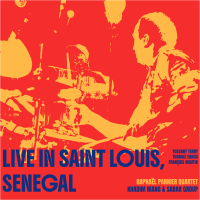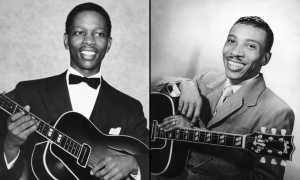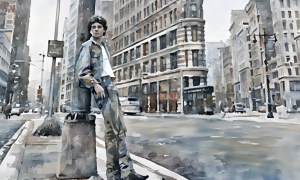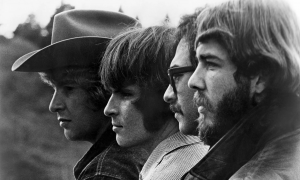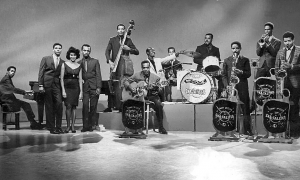Home » Jazz Articles » Groove Orbit » Rhythm and Roots: The Influence of Jazz on Ska and Early Reggae
Rhythm and Roots: The Influence of Jazz on Ska and Early Reggae

While contemporary reggae might seem far removed from jazz, it is important to understand how jazz played a major part in its early development.
During the late 1940s and early 1950s, the musical landscape of Jamaica looked quite a bit different than it would years later. As sound system operator Monte Blake explains, "in those days, there was no Jamaican music." Popular music was generally from Latin America, Cuba, or The United States. Mento, which is often confused with calypso, was probably the closest to true Jamaican music. Things took a turn, however, when Hedley Jones, a musical and electronics jack-of-all-trades came along.
Hedley Jones was always interested in music. He built his own instruments and was proficient on several different instruments himself. In 1939, the guitar became his main focus after hearing a recording by Charlie Christian. A year later, Jones created one of the first solid-body electric guitars, predating Les Paul's "Log" guitar. Hedley Jones would later serve in the British military during World War II, where he learned even more about electronics.
Upon his return to Jamaica, he realized that there was, as he put it, "almost a dearth of music." After the war, many of the local musicians had emigrated to Britain, and the remaining players found work in the northern part of the island, entertaining tourists in posh Montego Bay nightclubs. As a result, the market for local entertainment in the poorer areas of Kingston had diminished.
Local markets served as a gathering place for entertainment on any given evening. While there were a few musical performances, most of the music was traditional calypso or mento. Eventually, Jones's knowledge of electronics and his love for music gave rise to something that would change Jamaican music significantly: the sound system.
Jones ran a local radio repair shop where he also sold records. The record store, Bop City, featured predominantly jazz recordings, and in order to draw customers into his store, he developed a powerful sound system, which allowed him to play records to a large audience in an attempt to draw them into his record store, where the music by big bands and jazz greats was featured. Although there were other outlets for broadcasting music to the public, his powerful setup is considered to be the earliest sound system in Jamaica.
During the forties and fifties, Jamaican radio stations patterned themselves after BBC radio, which often featured a limited selection of music. Although the public demand for jazz and blues was on the rise, broadcasters did not seem interested in changing their formats. As a result, the emerging popularity of the sound systems allowed more access to the music audiences wanted to hear. The sound system operators were essentially DJs, who tried to attract listeners to their booths by playing the latest music, frequently accompanied by food and alcohol as well. During the late fifties, Duke Reid, Prince Buster, and Coxsone Dodd became the sound system leaders. The competition among the sound systems was fierce, and each of the three wanted to play music no one else was playing. They would sometimes resort to measures such as scratching off the name and title on the records, so no one would be able to identify the music.
Dodd had a longstanding fascination with sound systems. He found work in the United States harvesting sugar cane. This gave him the opportunity to purchase records that were unavailable in Jamaica. Upon his return to Jamaica, he wanted to set up his own sound system at his mother's liquor store. At that time, liquor stores in Jamaica were actually more like pubs, so these would be gathering spots for local entertainment. This gave him a perfect opportunity to do what he had wanted to do for years. As Lloyd Bradley describes it, Dodd "was an avid jazz fan and his ambition since he was a boy was to run his own set." He brought his collection of records, which included artists such as Charlie Parker, Dizzy Gillespie, and Coleman Hawkins.
The drive for originality, however, became more challenging. It was difficult to continue finding obscure jazz due to the rising popularity of rock and roll. As a means of ensuring exclusivity, Dodd began recruiting local musicians to record in order to play in his sound systems, which had grown in number at this point. As he explains, "I decided to make some local recordings of my own for the sound system. When I started, I didn't realize it could be a commercial business to the extent I'd sell my own records." After noticing a demand for the recordings, he began producing larger quantities for sale, which eventually led to the advent of Studio One, which was the first black-owned recording studio in Jamaica.
As the demand for recordings increased, Dodd was on the lookout for talented musicians. Locating players with the skill level he needed might have been challenging had it not been for a Catholic nun from the Alpha Boys' school. The musicians from the school fulfilled, as David Bradley explains, "Coxsone's dreams of initiating a jazz genre with a genuine Jamaican flavor, by laying bebop-style solos and big band instrumentation over a solid backing."
Sister Mary Ignatius Davies was born in Kingston and educated at the Alpha School for Girls. The Alpha School was established in 1880 and was divided into a girls' school and a boys' school. The Alpha School originated as a means of providing education to impoverished children in Kingston. Davies joined The Sisters of Mercy at 19 and started teaching primary school. She eventually became an important figure at the Alpha Boys' school and is also remembered as one of the major influences on many of Jamaica's most important musicians. Along with her desire to help others in need, she also had a passion for jazz. The school provided a means for young people to learn a trade, and music was one of the popular subjects. the Alpha School's music program started in 1892, but the music taught was mainly traditional brass band arrangements. Davies changed that dramatically.
Davies placed more emphasis on jazz in the music program at the Alpha School. Although sometimes pictured playing saxophone, Sister Ignatius wasn't as musically inclined as her students. She did, however, have an understanding of jazz. She also had an extensive collection of jazz and blues records. She cared about her students, but she was also demanding. As Bradley explains, "the only things stricter than the discipline were the music lessons." Most of the greatest ska and reggae artists have mentioned her as their greatest inspiration.
Musicians from the Alpha Boys School became the Jamaican equivalent of the Wrecking Crew for Studio One. They appeared on dozens of recordings and some of them formed a band, The Skatelites, which was one of the most popular Jamaican groups of the early sixties. While the Alpha School musicians were important, Ernest Ranglin was one of the central figures in creating this new sound. National Public Radio's World Café argues that "Ranglin was the one who turned the beat around and invented ska, the building block of reggae and all Jamaican music that has followed." Ranglin corroborates this statement. In an interview with Guitar World magazine, he says, "I invented the music, but not the word. And even reggae—I didn't invent that word either, but I invented the music."
Although Ranglin is often cited as a reggae guitarist, he is a jazz player at heart. He acknowledges Charlie Parker and Dizzy Gillespie as two of his main inspirations. When Studio One was in its earliest days, Ranglin was performing at the tourist clubs on the northern part of the island. Dodd hired him to be an arranger on the recording sessions.
At first, Dodd didn't want to completely change the sound of the music the musicians played; he simply wanted to make it a unique Jamaican sound. As Ranglin mentioned, his idea was that "there are the same four beats in a bar, but you can change the accents, giving the music a different feel. As a result, players started emphasizing the second and fourth beat of each measure." Ranglin described the rhythm as simply a shuffle. "Same thing they used to play in boogie-woogie. The only thing is we emphasized those beats a little more. That was the only trick." Artists such as Louis Jordan, T-Bone Walker, and Professor Longhair had been doing this for years, but the emphasis on the offbeats was somewhat stronger in this case.
Although Dodd was trying to create his own take on American R&B, jazz was at its core. Musicians like Ranglin along with the Alpha School alumni like the Skatellites wanted a chance to play. Many of the early recordings, such as "Roll On Sweet Don" and "Calypso Jazz" show how adept at improvisation these musicians were. One of the Alpha School musicians, Don Drummond, was considered by many as the best trombonist in the world.
These Studio One sessions became the foundation not only for ska, but for rocksteady and reggae as well. While contemporary reggae might seem far removed from jazz, it is important to understand how jazz played a major part in its early development.
Tags
History of Jazz
Kyle Simpler
Charlie Christian
Les Paul
Charlie Parker
Dizzy Gillespie
Coleman Hawkins
Ernest Ranglin
Louis Jordan
T-Bone Walker
Professor Longhair
Don Drummond
PREVIOUS / NEXT
Support All About Jazz
 All About Jazz has been a pillar of jazz since 1995, championing it as an art form and, more importantly, supporting the musicians who make it. Our enduring commitment has made "AAJ" one of the most culturally important websites of its kind, read by hundreds of thousands of fans, musicians and industry figures every month.
All About Jazz has been a pillar of jazz since 1995, championing it as an art form and, more importantly, supporting the musicians who make it. Our enduring commitment has made "AAJ" one of the most culturally important websites of its kind, read by hundreds of thousands of fans, musicians and industry figures every month.








